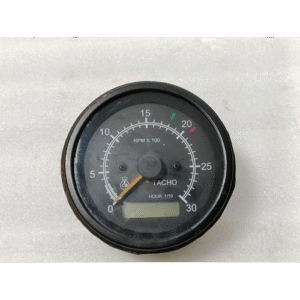- AUTOMATION EQUIPMENT
- ELECTRICAL ITEMS
- AMPLIFIER & UPS
- BATTERY CHARGER & INVERTER
- CIRCUIT BREAKER & BLOCKS
- CONTROL UNIT
- ELECTRIC CONTROLLERS
- FIRE ALARAM SYSTEM
- FUSES & CAPACITOR
- HEADPHONE & SPEAKER
- HMI & DISPLAY
- MISC ELECTRICAL
- PCB
- PLC SYSTEMS
- POWER SUPPLY
- PRINTER & CPU
- RELAY
- SENSORS
- SERVO DRIVES & MOTORS
- TELECOME & COMMUNICATION
- THERMOSTAT
- UNCATEGORIZED
DONGNAM GAUGE TACHO METER DNR 102 ELECTRONIC TYPE
₹8,238.00 Original price was: ₹8,238.00.₹8,017.00Current price is: ₹8,017.00.
| Product Conditioned | USED |
|---|
Free Shipping apply to all orders over $199
Guaranteed Money Back in 30 days return.
24/7 Customer Support
Share:
Hotline Order:
(+101) 5620 - 8155
Email ID:
xstore@support.com
Product Overview: Dongnam Gauge DNR 102 Electronic Tachometer
The Dongnam Gauge DNR 102 is a robust and highly reliable electronic tachometer designed for precise rotational speed measurement in a wide range of industrial and vehicular applications. As an “Electronic Type” meter, it utilizes modern sensor technology for superior accuracy and stability compared to older mechanical-driven tachometers.
Its primary function is to measure and display the Revolutions Per Minute (RPM) of engines, motors, shafts, and other rotating machinery. The “DNR” designation typically refers to the model series, with “102” being a specific variant, often characterized by its size, connection type, or measurement range.
Key Features & Benefits
-
Electronic Operation:
-
Benefit: High accuracy and reliability. It is not prone to the wear and tear, cable failure, or slippage issues associated with mechanical tachometers.
-
How it Works: Typically receives a pulsed signal from a sensor (e.g., magnetic pickup sensor, proximity sensor, or from the ignition system) and converts it into a precise RPM reading.
-
-
Clear, Analog Display:
-
Benefit: Easy-to-read dial allows for quick speed assessment at a glance, which is crucial for operators to maintain optimal and safe operating speeds.
-
Design: Features a classic needle indicator on a calibrated scale, often with color-coded zones (e.g., Green for safe, Red for over-speed).
-
-
Durable Construction:
-
Benefit: Built to withstand harsh operating environments commonly found in industrial settings, construction machinery, marine applications, and heavy-duty vehicles.
-
Components: Typically housed in a black, phenolic or metal case with a glass or polycarbonate lens to resist dust, moisture, and vibration.
-
-
Wide Range of Applications:
-
Benefit: A versatile instrument suitable for various engines and motors (Diesel, Gasoline, LPG) and machinery.
-
Compatibility: Can be configured to work with different pulse sources (pulses per revolution), making it adaptable to many systems.
-
-
Easy Installation:
-
Benefit: Simplified setup compared to mechanical units. Requires connection to a power source, ground, and the signal input from the sensor or ignition coil.
-
Typical Technical Specifications
(Note: Exact specifications can vary. Always consult the specific datasheet for the DNR 102 model.)
-
Model: DNR 102
-
Type: Electronic, Analog (Pointer/Gauge)
-
Display: Analog meter with needle pointer.
-
Scale: RPM (Revolutions Per Minute). Available in various ranges (e.g., 0-1000, 0-3000, 0-5000, 0-8000 RPM) to match the application.
-
Power Supply: Commonly 12V or 24V DC, compatible with standard vehicle and industrial electrical systems.
-
Signal Input: Accepts pulse signals from:
-
Magnetic Pickup Sensors (MPS)
-
Proximity Sensors
-
Ignition Coil (Tachometer terminal)
-
-
Pulses Per Revolution (PPR): Often adjustable or available in specific versions (e.g., 1 PPR, 2 PPR, 4 PPR) to match the sensor or engine characteristics.
-
Mounting: Standard panel mount, likely with a Ø52mm diameter, a very common size for industrial gauges.
-
Case Material: Phenolic resin or metal.
-
Lens: Glass or clear plastic.
-
Ingress Protection (IP): Likely rated IP52 or similar, offering protection against dust and water droplets.
Common Applications
The Dongnam DNR 102 Tachometer is ideal for use on:
-
Industrial Diesel Engines: Generators, pumps, compressors.
-
Heavy Equipment: Excavators, bulldozers, loaders, cranes.
-
Marine Engines: Boats and ships.
-
Agricultural Machinery: Tractors, combines.
-
Construction Vehicles.
-
Stationary Motors and Power Units.
Why Choose the Dongnam DNR 102?
-
Proven Reliability: Dongnam Gauge is a recognized manufacturer of industrial instruments, known for producing durable and cost-effective products.
-
Improved Accuracy: Electronic signal processing provides a more stable and accurate reading than mechanical alternatives.
-
Direct Replacement: Its standard size and electronic input make it an excellent upgrade or replacement for failing mechanical tachometers in many systems.
-
Operator Safety: Helps prevent engine over-speed, which can lead to catastrophic failure, by providing a clear and immediate visual warning.
We're here when you need us
Get a Quick Quote
Complete our online form.
Call US
Speak to one of our team.
Live Chat
Send us a message
Speak to one of our team.















